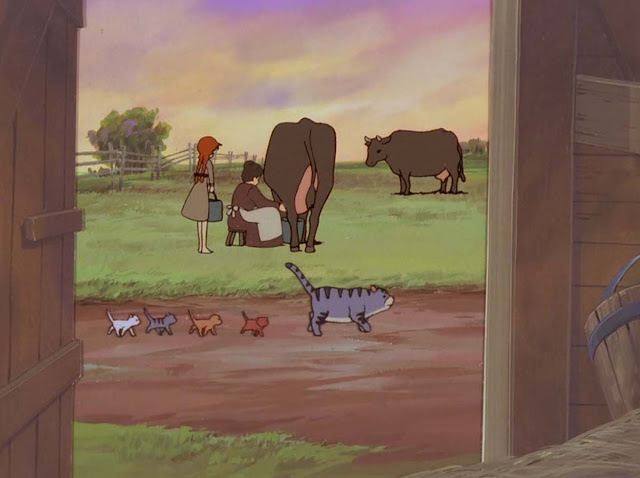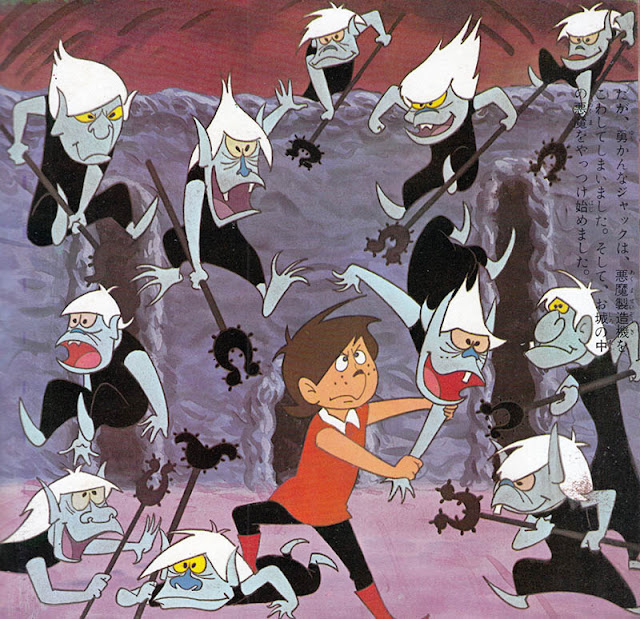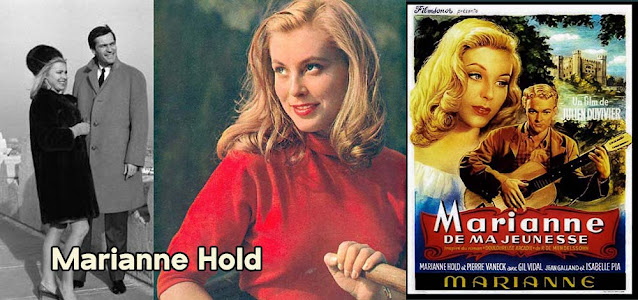Let me start with a personal note. I grew up in the US, but twenty years back I moved to Ontario to begin a new adventure north of the border. As a new Canadian, I lacked the cultural background that informed the upbringing of many of my new friends and coworkers. I didn't know Mr. Dressup or The Friendly Giant. I was sadly unaware The Littlest Hobo was, in fact, a dog. I'd never been to the Pop Shoppe, didn’t know who Tim Horton played hockey for, never watched Late Great Movies On Citytv. But there was one Canadian cultural giant that I and millions of others were aware of, one that predated SCTV, Celine Dion and the Kids In The Hall. Perhaps the biggest early Canadian pop culture export? An orphan girl named Anne.
 |
| my Anne LDs |
The story of a child finding a home and a life in turn of the century Prince Edward Island, Lucy Maud Montgomery’s 1908 novel Anne Of Green Gables has sold fifty million copies, been translated into 35 languages, and has been the subject of films, TV shows and stage plays. This red-headed heroine appears in a bewildering variety of media including dolls, toys, picture books, musicals, museums, costumes, even license plates for the fictional Anne’s very real province of PEI. L.M. Montgomery was from PEI herself and used her childhood as inspiration for what would eventually become a series of Green Gables novels, even as she moved to Ontario and what we’d now call the Greater Toronto Area.

drive carefully, Anne lives here
There's a part in Montgomery's novel where the fire in the Green Gables hearth on a November night is described as "the sunshine of a hundred summers being distilled from the maple cord-wood" and I'm reading this and asking myself, did that L.M. just get away with this? She did, didn't she. The prose of Anne Of Green Gables is filled with minute, evocative, almost-sentimental touches of descriptive poetry - certainly in keeping with the Gilded Age provenance of its origins - and it speaks to the determination of Anne and through her, Montgomery, to find the beauty and wonder in what at first glance might seem to be unexceptional places, humdrum tasks and the sometimes tragic moments that make up life, a tall order for an unwanted child in a world that has almost no sympathy or resources for anything other than itself.
Anne begins with middle-aged siblings Marilla and Matthew Cuthbert requesting a boy orphan to adopt to help out around their Avonlea farm, as if they were buying a draft horse or ordering a new plow. When Anne arrives instead, there’s some clinical calculus as the Cuthberts weigh their agricultural needs against the literal welfare of a child. At this time, Canada was seen as a convenient destination for the unwanted children of late-period British Empire; from 1869 right up until the late 1940s the UK sent something like a hundred thousand children to homes across Canada. Most would spend their remaining childhood as de facto indentured domestic servants or field hands. The reality is that most of these children weren’t actually orphaned; most had parents overcome by financial or personal disaster, forced by circumstances to break up their families. Anne’s orphan drama played out in real life for decades on train platforms across the country from Nova Scotia to British Columbia.
 |
| my Anne cel |
We first see Anne as an awkward tween, sometimes overwhelmed as her overclocked imagination battles her desperate desire to belong. She matures to become a self-disciplined young woman determined to make something of herself, along the way, pulling Marilla and Matthew out of their gruff, glum routine and into a more fulfilled, if less orderly life, while making friends and rivals alike at the local school. Anne's overworked sensitivity shows its negative side when she overreacts to minor things, exploding them into major life-altering events as only a too-dramatic teen - which is all of them - can blow ‘em up.

that girl is trouble, and is IN trouble
Cheerful perseverance in the face of hardship and an ability to tease the fantastical out of the everyday spoke to audiences around the world, even early Taishō era Japan, which is when the novel was first published in Japanese. Though suppressed along with other Western literature during the Pacific War, during the Occupation Anne Of Green Gables was put on General MacArthur’s Recommended Children’s Literature list, along with another classic of rural kid-lit, Little House On The Prairie. Both series would inspire enduring fanbases and Nippon Animation anime series. And that’s where we here at Let’s Anime come in.
Fifty episodes of Nippon Animation's Akage no Anne (“akage” means “redhead”) would air on Fuji-TV from January to December of 1979. Anne was the first series under the banner of World Masterpiece Theater, a showcase that started as Calpis Comic Theater, then became Calpis Children's Theater and then 1978’s Perrine Story saw the title remixed to Calpis Family Theater, and then next year somehow changed again to World Masterpiece Theater for Anne. In 1986 the banner changed yet again to House Foods World Masterpiece Theater. Stay tuned, who knows what they’ll call it next? Anne of Green Gables would join Nippon Animation’s roster of exports, airing in Korea, Spain, Germany, Portugal, the Arabic world, the Philippines, Italy, France, and French-speaking Canada. A South African English dub would broadcast in Taiwan and South Africa.

Marilla, Matthew, Anne, and PEI's Strategic Potato Reserve
Directed overall by anime legend Isao “Horus Prince Of The Sun” Takahata, Anne’s character designs were by animation director and fellow anime legend Yoshifumi “Future Boy Conan” Kondo. Reference for the wonderful backgrounds, art-directed by Masahiro Ioka, was provided by a July ‘78 research trip to Prince Edward Island by Kondo, Takahata and Nippon Animation producers Junzô Nakajima and Shigeo Endô. You’ll swear you hear Joe Hisashi in the soundtrack but that’s all Akira Miyoshi there, bringing Anne's fantastical imagination to musical life in a beautiful Hayao Miyazaki-animated OP.
 |
| sure, just put some airplanes in there, Hayao |
Miyazaki did layouts for the first 15 episodes of Anne, perhaps repaying Takahata for the help Takahata gave on the recently completed Future Boy Conan. But Takahata’s realistic, textural vision for Anne was at odds with Miyazaki’s desire to expand upon the source material, as he did with Conan. Soon Hayao would leave the show and Nippon Animation entirely. Watching the series with 2024 eyes, we see what legions of internet memelords would later call “the Ghibli aesthetic” are all present in ‘79; the cozy fires, the tempting food, the homey overstuffed sofas and Victorian comfort of the giant overcoats and pinafores and moustaches, far enough in the past to be hazy and nostalgic but not so far in the past that we can’t enjoy ice cream or trains.
 |
| the aesthetic in full force |
This nostalgia helps the show - and the novel - breeze past some of the more brutal realities of the era, the first of which is how orphans were treated like one more exploitable natural resource. Pay attention to how Anne talks about her life before Green Gables, it’s a life of constant toil, either caring for somebody else’s children or cleaning somebody else’s house or trying to keep somebody else from dying from some Victorian illness. It’s no wonder the girl would spend as much time as possible conjuring up fanciful stories about trees and rocks and streams - 19th century reality is harsh. Like the Little House series, Anne seems to work as a subtle hint to modern readers that no matter how awful their own childhood may be, at least they weren’t stuck doing farm chores or battling cholera in a time before Hot Wheels and Barbies.
 |
| before Green Gables, things were a little grim |
On television as in the novel, we see a hopeful Anne arrive at the train station en route to surprising everyone at the home she’ll soon name Green Gables. Anne makes a friend in Diana Barry from the next farm over, and a fierce rival in dashing local boy Gilbert Blythe. She meets her own personal Nellie Olesons in the spiteful Pye sisters, charms the various busybodies and old biddies of Avonlea, wins an academic scholarship to Queen’s Academy in Charlottetown, and from there wins another scholarship to a mainland university, forcing her to consider leaving Green Gables behind forever.
Anneheads and Gable-otaku, rest assured all your favorite story beats are in the show, whether it’s the part where Anne dyes her hair green or the part where Anne defies death by walking across the ridgepole of the Barry’s roof. We indeed see Anne conjure up a rich fantasy life as the tragic, raven-haired beauty Lady Cordelia Fitzgerald, which leads to the tragic loss(?) of Marilla’s emerald brooch. Anne gets Diana drunk, Anne bakes the cough-syrup cake, and then Anne gets trapped on the pond, only to be rescued by the last person on Earth she’d ever want to rescue her.
Seemingly overnight, Anne transforms from a gawky tween into a Young Lady as the rest of her body catches up with her once oversized skull. The last quarter of the series is a show about an adult (teenagers hadn’t been invented yet) dealing with isolation, aging parents, career choices, tragedy, and the kind of exam anxiety staring Japanese viewers right in the face. Also anxious was the Nippon Animation team producing the show. Whatever slack they’d had early in the production was gone thirty weeks in as the crew dealt with an exodus of talent pulled away to work on Galaxy Expresses, Lupins, and Bannertails, not to mention subcontractor issues and staff downtime due to illness. However, the Anne anime remains entertaining even as the animation quality suffers, due to its firm foundation of gorgeous background illustration and solid character design.

will the princess be forced to marry someone she can't stand?
Given free rein with Anne, Hayao Miyazaki probably would have placed more emphasis on fantasy segments conjured out of Anne’s more whimsical notions. But Takahata - whose own daughter was Anne’s age - put his foot down, keeping the show firmly rooted in PEI’s famous red soil, perhaps hastening Miyazaki’s exit towards TMS and the direction of a popular Lupin III film. Akage no Anne shares the same sensibility as the rest of the World Masterpiece Cinematic Universe; action and spectacle are underplayed in favor of characters and feelings, set against well-researched architecture and lush watercolored backgrounds. Takahata’s quieter, grounded Anne has an emotional weight it might lose if set amidst Miyazaki’s trademark contrabulous fabtraptions and death-defying action sequences. Anne would also be Takahata’s swan song at Nippon Animation; next for him would be Chie The Brat for TMS.

Anne merchandise includes this bicycle (bicycle does not fly)
45 years later Akage no Anne still entertains. There’s a double hit of nostalgia, both for the original property and for its 1979 version, which gleams with those wonderful Masahiro Ioka landscapes and Kondo’s characters. At the time it was up against shoujo opposition like Candy Candy, Lun Lun the Flower Angel, Rose Of Versailles, and Haikara-san ga Tōru, and sequels to Space Battleship Yamato, Science Ninja Team Gatchaman, Cyborg 009, and Star Of The Giants. And there was something called Mobile Suit Gundam that came out that year. But even without a tacked-on animal companion, New Type powers or cybernetic augmentation, Green Gables welcomes and rewards repeat visits.
 |
| keep your dreams in your Anne Dream Can |
Everyone, that is, but the North American viewing audience, which has seen Anne as the star of silent films, musicals, the Megan Follows CBC show and a Canadian cartoon, but so far hasn’t been permitted to see this anime version. The absence of Nippon Animation’s Anne is a loss for us all, whether we’re students facing book report deadlines, executors of the L.M. Montgomery estate, or the hardworking staff of the PEI Ministry Of Fisheries, Tourism, Sport, and Culture, who’d probably appreciate an extra bit of attention come vacation booking season.
Nope, Americans can’t watch Anne Of Green Gables. Well, okay, you can, the show is up on YouTube with the English-accented English dub, and with subtitles But there isn’t a legit Blu-Ray set, no official release, it’s not real here in the way the GKids Future Boy Conan is. Absent the anime show or a trip to PEI, maybe all we can do is spend a fall afternoon in the Ontario countryside, visiting L.M. Montgomery’s 1911-1926 Leaskdale Manse home or maybe the park near where she later lived on Riverside Drive in Toronto. On the way you can stop in anywhere that sells books and pick up the copy of Anne Of Green Gables you’ll find there.
 |
| Leaskdale, just north of Uxbridge, L.M. says "have a seat" |
An inescapable layer of Canadian cultural bedrock, Anne is so much a part of the landscape here that one could almost believe she was a real person. If we ever needed someone to remind us what it’s like to dream big dreams once in a while, Anne of Green Gables is the person to do it, real or not, whether live-action or animated, whether in prose or radio or film or TV or whatever medium you choose. Can we dream big enough to see Akage no Anne finally return home?
-Dave Merrill
I am tremendously indebted to Animétudes and their amazingly well-researched and comprehensive look at the production of Akage no Anne.















































